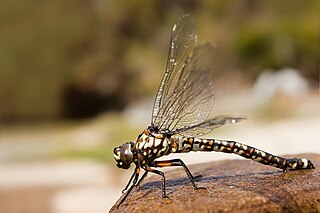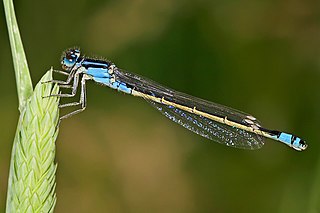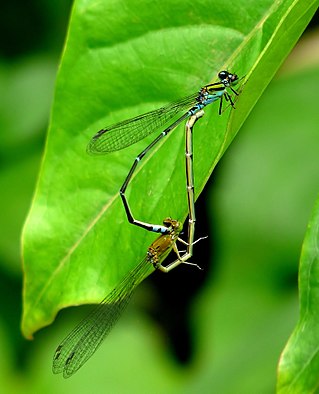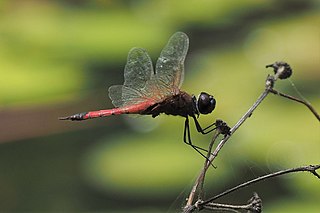
The Aeshnidae, also called aeshnids, hawkers, or darners, is a family of dragonflies. The family includes the largest dragonflies found in North America and Europe and among the largest dragonflies on the planet.

The insect family Coenagrionidae is placed in the order Odonata and the suborder Zygoptera. The Zygoptera are the damselflies, which although less known than the dragonflies, are no less common. More than 1,300 species are in this family, making it the largest damselfly family. The family Coenagrionidae has six subfamilies: Agriocnemidinae, Argiinae, Coenagrioninae, Ischnurinae, Leptobasinae, and Pseudagrioninae.

Rhionaeschna is the scientific name of a genus of dragonflies from the family Aeshnidae. They are also known as blue-eyed darners.

Pantala flavescens, the globe skimmer, globe wanderer or wandering glider, is a wide-ranging dragonfly of the family Libellulidae. This species and Pantala hymenaea, the "spot-winged glider", are the only members of the genus Pantala. It was first described by Johan Christian Fabricius in 1798. It is considered to be the most widespread dragonfly on the planet with good population on every continent except Antarctica although rare in Europe. Globe skimmers make an annual multigenerational journey of some 18,000 km ; to complete the migration, individual globe skimmers fly more than 6,000 km —one of the farthest known migrations of all insect species.

Sympetrum is a genus of small to medium-sized skimmer dragonflies, known as darters in the UK and as meadowhawks in North America. The more than 50 species predominantly live in the temperate zone of the Northern Hemisphere; no Sympetrum species is native to Australia.

Erythrodiplax is a large Neotropical genus of dragonflies in the family Libellulidae. These small to medium-sized skimmers are commonly known as dragonlets.

Gynacantha is a genus of dragonflies in the family Aeshnidae. The females have two prominent spines under the last abdominal segment. This gives the genus name and the common name two-spined darners; they are also known as duskhawkers.

Ischnura is a genus of damselflies known as forktails in the family Coenagrionidae. Forktails are distributed worldwide, including various oceanic islands. The males have a forked projection at the tip of the abdomen which gives the group their common name.

Pseudagrion is the largest genus of damselfly in the family Coenagrionidae, with over 140 species. Its range includes most of Africa, much of Asia, and Australia. Africa holds most of the diversity with almost 100 species. It has occupied most of the freshwater habitats in its range, and dominates damselfly communities in habitats as different as desert pools, equatorial rainforests and montane streams.

Teinobasis is a genus of damselflies in the family Coenagrionidae. Species occur in south-eastern Asia, Indonesia, Solomon Islands and Micronesia; one species, Teinobasis rufithorax, is found in Australia.

Tramea is a genus of dragonflies in the family Libellulidae, the skimmers and perchers. Species of Tramea are found in tropical and subtropical regions around the globe. They typically have colored bases to their otherwise translucent hindwings. In particular when they fly, this creates the impression of their carrying bags at the start of their abdomens. They are known commonly as saddlebags or saddlebags gliders.

Zygonyx is a genus of dragonflies in the family Libellulidae. They are commonly known as cascaders because of their preference for living beside waterfalls and flying through the spray. They lay their eggs in wet dangling roots.

Tramea transmarina, known as the red glider or northern glider, is a species of dragonfly in the Libellulidae family. The type locality for Tramea transmarina is Fiji, but subspecies are found in the islands of the Pacific, north-eastern Australia and Southeast Asia.

Sympetrum illotum, the cardinal meadowhawk, is a species of skimmer in the dragonfly family Libellulidae. It is found in the Caribbean Sea, Central America, North America, and South America.































